Syria
 From Rationalwiki
From Rationalwiki _-_SYR_-_UNOCHA.svg.png)
“”Syria, using the term in its old, geographical sense, occupies a unique place in the annals of the world. Especially because of the inclusion of Palestine and Phoenicia within its ancient boundaries, it has made a more significant contribution to the moral and spiritual progress of mankind than any other comparable land. Small as it appears on a map or a globe, its historical importance is boundless, its influence universal.
|
| —Philip K. Hitti, Lebanese-American professor at Harvard and Princeton.[1] |
“”We do not have a country called Syria anymore. We lost everything. There is nothing left in Syria. So, if we are talking about an end, it is already here.
|
| —Fayrouz, refugee who fled Syria after losing their home to a bomb.[2] |
The Syrian Arab Republic, commonly known as Syria, used to be a country in the Middle East. Today, Syria is a country-sized battlefield that was fought over by the now-deposed murderous dictator Bashar al-Assad, DAESH remnants, Al-Qaeda psychos, proxies of Iran, proxies of Turkey, private military companies like the Russian-controlled Wagner Group, various oppressed minorities fighting to secede, and supposed moderate rebels. Millions of Syrians no longer live in Syria, having fled the country to avoid being massacred but still facing harsh conditions in refugee camps around the world.[2] As suggested by the name, most of the Syrian population are Muslim Arabs, although the country is and was quite racially and religiously diverse.
It wasn't always this way. As with other states in the Levant, Syria was home to many ancient civilizations. Aleppo and Damascus are among the world's oldest continuously inhabited cities,![]() dating back roughly 4,000 years. Syria was also a significant region in the Roman Empire, with many buildings dating from that time still present. In the Islamic golden era, Syria was one of the centers of Arab civilization, serving as the seat of the Umayyad Caliphate. The region then came under the rule of the Ottoman Empire until it was seized by France during World War I and made into a League of Nations mandated colony. The French colonial empire treated Syria terribly, turning its people against each other based on religion and even bombing Damascus during World War II to prevent the country's secession from the empire. Only under Allied pressure did France finally agree to the country's independence in 1945.
dating back roughly 4,000 years. Syria was also a significant region in the Roman Empire, with many buildings dating from that time still present. In the Islamic golden era, Syria was one of the centers of Arab civilization, serving as the seat of the Umayyad Caliphate. The region then came under the rule of the Ottoman Empire until it was seized by France during World War I and made into a League of Nations mandated colony. The French colonial empire treated Syria terribly, turning its people against each other based on religion and even bombing Damascus during World War II to prevent the country's secession from the empire. Only under Allied pressure did France finally agree to the country's independence in 1945.
The post-independence period was marked by infighting and coups, culminating with a military takeover in 1963 that left the Ba'ath Party in power. In 1971, Hafez al-Assad took power, ruling as a strict and murderous dictator. His son Bashar proved even worse, cracking down on dissent during the Arab Spring and plunging the country into a horrific civil war in 2011. That war continues, marked by extensive foreign intervention and frequent human rights abuses and war crimes. In 2024, al-Assad was overthrown by rebels after an 11-day offensive.
About the name[edit]
The name "Syria" comes from the Ancient Greek language, Σύριοι, or Sýrioi, and it was applied to the region during the time when the Greek Seleucid Empire ruled Persia and the Levant.[3] At this time, though, the name Syria applied to the entire eastern Mediterranean coastline, including the Phoenicians of ancient Lebanon and the tribal peoples of ancient Israel. It's likely that the Greeks took the name Syria by shortening their word for the Assyrian Empire of Ancient Mesopotamia, Assyrioi.[4]
It wasn't until the Roman Empire when "Syria" got divided into various provinces that more closely reflected the actual cultural makeup of that part of the world. Most of modern Syria was placed into the province of Coele-Syria, or "Hollow Syria."[5]
Basically, it's just another example of how arbitrary imperialists can be when drawing lines and naming shit on maps.
History[edit]
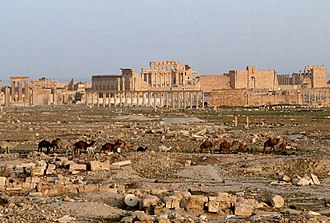
Ancient Syria[edit]
Like the rest of the Levant, Syria grew its fortunes through trade with Ancient Egypt and Mesopotamia. The earliest true civilization in Syria was Ebla, founded sometime around 3500 BCE.[8] Ebla was rich and powerful due to its control of the inland trade networks that connected Egypt and Mesopotamia. This made it a prime target for conquest, though, and it would be destroyed several times before fading into obscurity.
Coastal Syria was home to the Phoenician civilization, who dominated trade routes and built great wealth by selling a rare purple dye.[9] The Phoenicians created the world's first phonetic alphabet, and their language evolved into Aramaic and then the modern Arabic language.[10] Inland Syria, meanwhile, became a constant battleground between various imperial powers from Egypt and Mesopotamia. The Phoenicians would themselves be conquered as well, getting tossed from the Persian Empire to Alexander the Great and then to the Seleucid Empire.
As a result of the region's conquest by Alexander the Great and subsequent rule by the Greek Seleucids, the region saw huge immigration by Greek citizens who in turn spread their culture and ideas throughout the region.[11] The Greeks acted like typical colonists, taking over existing cities and building new ones to be named after themselves. It was the Greeks who introduced the name "Syria" to the region, as discussed above.
Roman rule[edit]
Under Roman general Pompey the Great, the Romans rolled in to conquer the entire eastern Mediterranean. While the most famous consequence of that was to place Israel under Roman rule, the Syrians became part of the empire as well. In Syria, the Romans inherited a thriving Greek-cultured region with already rich cities like Palmyra and Damascus.[11] Syria paid well in taxes, so the Romans in turn invested heavily in the region, further building the region's economy and leaving behind some magnificent ruins.
The Roman's weren't uncontested in their rule of Syria. The Persians overthrew the Greeks to establish the Parthian Empire, and they would become a major military threat to the eastern Roman possessions for centuries to come.[12] These constant wars over the eastern Mediterranean contributed to the gradual weakening of both empires.

Roman theatre at Bosra.
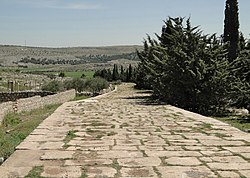
Ancient Roman road to Antioch.

Colonnade at Apamea.
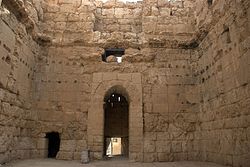
Temple of Zeus in Dumair.
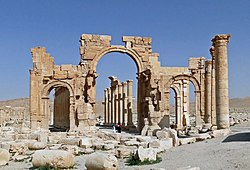
Arch of Septimus Severus, destroyed by DAESH.[13]
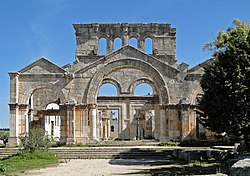
During the time of the Byzantine Empire, Syria came under significant Christian influence as the religion became adopted by the empire as a whole. The city of Antioch near Syria was one of the most significant centers of early Christian worship and conversion to the point where it's referred to as the "Cradle of Christianity."[14] The religion gained significant following among the Syrian people, and to this day about 10% of the Syrian population still practice some form of Christianity.[15]
Caliphate conquest and rule[edit]

The Byzantine Empire, the successor to the Roman Empire, faltered and weakened as a result of its constant wars with the Persians. The high cost in blood and treasure these wars demanded ensured that neither power was able to resist the oncoming storm that would be brought on by the rise of Muhammad and his unification of the Arabian Peninsula. The great city of Damascus, then the center of Syrian civilization, fell to the Rashidun Caliphate in 635 CE, just a few years after the prophet's death.[16]
The Rashidun Caliphate proved surprisingly magnanimous to its non-Muslim subjects in the conquered regions. Christians and Jews had the right to worship freely, and that freedom came at the relatively minor price of higher taxes and exclusion from certain government posts.[17] Kinda shitty by today's standards, but pretty damn good compared to Europe during the Middle Ages. Medina served as the empire's capital, while the Mosque of the Prophet served as the direct seat of government.
The Rashidun rulers were succeeded by the Umayyads, who rose to power after the last Rashidun caliph was assassinated. Opposition to their rule permanently split the Islamic religion, and the Umayyads responded by becoming much more authoritarian than previous caliphs.[18] In order to create a decisive split from the old ways, they also moved their administration away from Medina and into the Syrian city of Damascus. Through Umayyad efforts at Arabization, Syria's population gradually adopted the Arabic language and culture over the preceding Greek and Aramaic.[19] The Umayyads were less concerned with religious conversion, though, as they quite liked the extra taxes they got from infidels. Nonetheless, the Syrian populace gradually converted under strong Arabic cultural influence.
The Umayyad court at Damascus also brought great prosperity to Syria, as learned scholars assembled there to pore over classical texts taken from the conquered Roman cities, foreign trade expanded greatly, and educated Jews and Christians found themselves paid to study medicine and alchemy.[19]
Crusades and other invasions[edit]
.jpg)
Things started to go wrong after the Umayyad Caliphate collapsed, as independent Muslim rulers fought each other over Syrian land. The caliphate was eventually replaced by the Abbasid Caliphate, which was plagued by wars in Syria, and then the Fatmid Caliphate, which proved itself much less tolerant of other religions than its predecessors. The Fatimids destroyed Christian and Jewish religious buildings, forcing those religious minorities to flee alongside the Druze into the mountains and the desert.[20] Fatimid misrule in this manner over places like Jerusalem helped form the justification for the Crusades, in which Western Christians armed themselves and poured into the Holy Land on a war to conquer the Levant.
The First Crusade focused on Jerusalem, but the Second Crusade of 1147 CE found itself with far more ambiguous goals, one of the reasons for its failure.[21] The Crusaders stupidly marched into the desert to take Damascus, despite the fact that it was a fucking desert and they didn't have enough water.[21] As anyone should and could have predicted, the Crusaders never got that far.

The centuries of warfare during the Crusades left Syria with a great architectural legacy of castles scattered all over the place. A big chunk of Syria was conquered and included in the Principality of Antioch,[22] and Christian and Muslim rulers built great fortresses to defend from each other. Much of the defense of the Middle East fell upon the great ruler Saladin, who unified much of the Middle East against the Crusaders and is still fondly remembered in Syria.[20] His death, however, plunged the Muslim world back into infighting.
Syria never caught a break after the tumult of the Crusades. The region suffered invasions by Turkish rulers and the Mongols. The Turkic Mongol warlord Timur Lenk also wreaked great damage upon Syria during his attack on the region, massacring religious minorities and destroying the region's economy.[23]
Ottoman rule[edit]
The rising Ottoman Empire conquered Syria in 1517 alongside Egypt and a big chunk of Arabia.[24] Typically for the early centuries of their empire, the Ottomans ruled Syria with a relatively light hand, delegating administrative and military affairs to local "pashas".[25] Syrians were generally well-off under this system. The Ottomans respected Arabic language and culture due to being the basis of the Quran and the culture of Muhammad. Syria also benefited from being the gate between Mecca and Turkey; as traffic to Mecca increased from those locations, Syria saw a great influx of cash from religious pilgrims.
Religious minorities in remote areas in Syria were carefully watched by the Ottomans, but those communities would not be harassed so long as they paid their taxes.[26] They imposed higher taxes on religious minorities, but they also offered the option to be exempt from that requirement in exchange for voluntary extended military service.[26]
The Ottoman Empire as a whole followed the same old historical trends and started to decline due to the burdens of forever wars with Persia and other powers. Control over administration faltered while elite government troops turned to banditry as the government failed to pay them.[26] (Another historical lesson is that you should always pay your soldiers). By 1831, this trend had gotten so bad that Egypt's governor Muhammad Ali (not that one) and his son Ibrahim Pasha effectively seceded from the empire and even militarily conquered the Levant.[27] Egyptian rule proved unpopular due to their harshness in collecting huge taxes and forcibly conscripting people. Unrest weakened Egypt, and European powers intervened militarily in 1839 to help the Ottomans retake the Levant out of fear that the empire's collapse would throw the Middle East into chaos.[28] That last part, by the way, is what we call foreshadowing...
Still, the resumption of Ottoman rule did not return things to the tranquil old ways. Greater European trade influence in the Levant saw the region flooded with cheap manufactured goods that put people out of business.[29] Sultan Abdul Hamid II, who took the throne in 1876, made things even worse by cracking down violently on the increasingly discontented and impoverished people of Syria, becoming known as "The Butcher."[25] This marked the point where the empire started becoming very, very brutal in its efforts to keep the Syrians in line.
World War I and aftermath[edit]

Educated Syrians by this point had become fully aware that the Ottoman Empire had become a burden and a threat to the region. Ottoman suppression of nationalist ideas only made the belief in a need for a separate Arab state more stringent. The Ottoman administrator of the region, Jamal Pasha, proved exceptionally ruthless in rooting out and killing Syrian nationalists.[30] Imperial cruelty towards Syria intensified when the empire joined the world war on the side of the Central Powers, using Syria as a military base from which to attack the British Empire's colonies in Egypt and Africa. Most infamously, Pasha had almost two dozen nationalists publicly executed in Damascus, an event now known as Martyr's Day.[31]
Meanwhile, the British reached out to the Arabs to encourage them to rise up against the empire, promising them a state in return. In actuality, the British and France secretly struck the Sykes-Picot Agreement to partition the Ottoman Empire into a series of colonies.[32] The Arabs presumably would have been pissed about this arrangement, but nobody told them anything until it was too late. During the Middle Eastern campaign, British and French troops joined in the fighting, and after the Ottomans were defeated they placed the region under their own occupation.
Hashemite heir Faisal was greeted as a hero by the Syrians and was proclaimed the king of a newly-independent Syrian Arab state.[30] At the Versailles Peace Conference, though, the Allies completed their backstab by refusing to acknowledge Syrian independence. The French overthrew King Faisal and took direct control of Syria as a colony, enraging the Syrians.[30] Syria had been independent for only a year.
French rule[edit]
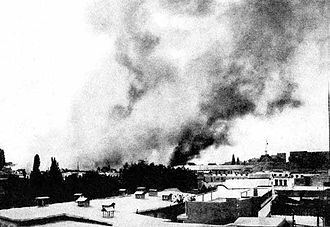
“”Sectarian conflict was a theoretical necessity for French colonialism in Syria, since the entire colonial mission was based on the idea of protecting one sectarian community, the Maronite Christians, from the predations of others. Without sectarian conflict, colonial justification evaporates.
|
| —Michael Provence, professor of Middle East history at University of California San Diego.[33] |
You can't really overestimate just how pissed off the Syrians were about how the French unfairly and two-facedly fucked them over. Trouble started when the French military administration started forcefully disarming people and using peasants and prisoners as forced labor.[34] French rule proved relentlessly authoritarian, as industries came under the control of French businessmen and Syrian students were forced to sing French colonial songs and learn the French language.[35] Syrians realized that they had traded one exploitative imperial ruler for another, and this one seemed to give even less of a shit about them.

Open revolt began among Muslims and Druze in 1925, while the French immediately denounced them as pro-feudalism and sectarian monsters intent on killing Christians.[33] The rebels, on the other hand, ignored that and did a rather good job of assembling a remarkable cross-religious alliance against French rule. Hoping to put a stop to things quickly, the French made a show of force by bombarding the rebel stronghold of Damascus for two days, killing thousands of people.[33] Damascus fell, but peasant unrest only intensified due to anger at the show of French cruelty.
Although costly, the French managed to put down the revolt by 1927 by shipping in tens of thousands more troops.[36] Afterwards, though, the French realized that direct rule would prove too difficult to maintain. The new French policy was the same old "divide and conquer" mentality used by the British. Their plan was to Syria into three pieces, an Alawi state in the north, a Sunni Muslim state at the center, and a Druze state in the south.[35] Ultimately, France decided on splitting Syria into five states: the Jabal Druze, Aleppo, Latakia, Damascus, and Alexandretta. They hoped to prey on regional differences as well as religious ones.
As a more conciliatory move, the French signed a treaty in 1936 promising eventual Syrian independence and then allowed them to elect their own government, albeit with colonialist limitations. The French parliament, however, never bothered to ratify the treaty, which was a bad sign.[35]
World War II and the Levant Crisis[edit]

“”After five years of experience, I am convinced that [de Gaulle] is the worst enemy of France in her troubles... he is one of the greatest dangers to European peace... I am sure that in the long run no understanding will be reached with General de Gaulle.
|
| —Winston Churchill during the Levant Crisis.[37] |
Syria didn't really become involved in the war until the 1940 collapse of France and the replacement of its government with the fascist puppet Vichy France. Although the Free French forces fought on against the fascists in exile, Syria went to the Vichy government in the divorce. In the aftermath of Allied defeats around the Mediterranean, Italy and Nazi Germany were poised to attack British holdings in Egypt. To prevent the Axis Powers from using Vichy airbases in Syria to contribute to that attack, the Allies invaded Vichy-held Syria and Lebanon in 1941 amid fierce Vichy resistance.[38]

In return for support from the Syrian people, French leader Charles de Gaulle promised the Syrians eventual independence.[39] Under a watchful French eye, the Syrians gradually took over most day-to-day governance in their own country. In 1944, overruling French objections, the United States and the Soviet Union jointly recognized Syria as an independent nation.[39] Not about to give up, though, the French made their own recognition of Syrian independence conditional on Syria's government signing a treaty that would have effectively turned the country into a French puppet state.
The Syrians were pissed at this betrayal, and in 1945 they started rioting while the Syrian government assembled its own army in preparation to fight their way out of the French empire if need be. In retaliation, the Free French troops stormed the Syrian parliament, cut off all electricity to Damascus, and then bombed the city again with artillery.[40] Basically, fuck colonial France.
The Syrian president managed to escape and ask Winston Churchill for help; luckily for the Syrians Churchill had already fallen out with de Gaulle over personality clashes and competing interests. Churchill rather quickly mobilized British troops and sent them into Damascus, where they peacefully but forcefully disarmed the French and confined them to barracks.[41] De Gaulle was apoplectic at this development and felt that he'd been backstabbed by an ally (how the tables turn), and the ensuing diplomatic crisis grew to a point where Free France and the United Kingdom almost clashed militarily.[42] Of course, it wasn't just Churchill that France had to deal with; the Soviet Union and the US also started breathing down de Gaulle's neck. After the war, the rest of the Allies pushed through a United Nations vote in 1946 that basically told the French to fuck off.[43] And for goddamn once, the French actually fucked off.
Independent republic[edit]
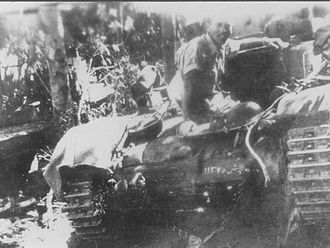
War and coups[edit]
For a brief moment, Syrians of all regions and religions were able to join forces to oppose the French. That unity ended the moment the French were out the door. The imposed divisiveness the French had used to keep the region in order caused a total breakdown in national identity. That crisis was to be postponed, however, as Syria immediately plunged itself into the crisis concerning Israel's independence in Palestine.
Syria joined the allied Arab war effort in 1948, invading through the Golan Heights and striking at the south of the Sea of Galilee.[44] The result was a tactical stalemate, although Israel claimed victory. The Syrian military proved too disorganized to continue the advance, and the more determined Israelis gradually pushed them back to the Golan Heights. Syria was the last Arab state to make peace with Israel, establishing a demilitarized zone across their shared border.[45] The demilitarized zone would not stay demilitarized.
The humiliating defeat against a much smaller state destabilized Syria's government, and the military almost immediately stepped in to dissolve the legislature and seize control of the government.[46] Then the leader of the first coup got deposed later in the same year by another military coup because the early Syrian government was basically a revolving door.

A third coup then returned Syria to a semblance of civilian rule, although the military breathed down their necks and waited for another opportunity to strike.[47] Syria by this point was undergoing total economic collapse, and the civilian government proved unable to cope with the problem due to the previous breakdowns in government authority. By 1951, this prompted a fourth coup, when Colonel Adib Shishakli arrested most of the civilian government and then banned political parties and elections.[47] Shishkali was a ruthless dictator, but even he wasn't able to control Syria. He promptly fell to a fifth coup in 1954. Like we said, revolving door.
Instability and radicalism[edit]
The downfall of Shishakli caused the fickle pendulum of Syrian power dynamics to swing leftward, specifically towards pro-Soviet communists and the rising Ba'ath Party. These parties most benefited from republicanism, as they were the only Syrian organizations with any political platforms beyond "fuck everyone who doesn't follow our religion" or total selfish acquisition of power at everyone else's expense. Both parties had some similar ideas, such as overturning the old feudal order, cooperating more closely with their Arab neighbors, and teaming up with the Soviets in the Cold War to counter Western influence.[48] That last part was especially important, since the Syrian people were still rather sore about those little betrayal-at-Versailles and decades-of-colonial-brutality things. The Syrians were then poisoned against the West even further in 1956, when the British Empire stupidly invaded Egypt alongside Israel and France during the Suez Crisis.[48]
By leveraging popular support and cooperating with each other, the communists and the Ba'athists managed to seize total control over the Syrian government by 1957, effectively cutting out the conservatives and fundamentalists.[48] Once on top, though, the two parties immediately started squabbling with each other for power. Such things tend to happen.[citation NOT needed]
United Arab Republic[edit]

The Ba'athists held the upper hand in the government, and they decided to take a significant step towards their Arab unity agenda while simultaneously fucking over the communists. They went to Egypt, whose leader Gamal Abdel Nasser was a pan-Arab quasi-socialist, and they proposed uniting their countries. Nasser might have been somewhat socialist, but he was staunchly anti-communist and had persecuted them harshly in his own country.[49]
The union was completed and confirmed by plebiscites in both countries, but the Syrians soon realized that they were woefully outweighed in the union by the much more economically powerful and populous Egypt. The United Arab Republic (UAR) was also dominated by Nasser, as he had ensured that he would possess extensive powers in the new government. Nasser set about marginalizing the Syrian Ba'athists and ignoring their wishes in implementing policies.[50] These policies ended up fucking over the Syrians by giving Egyptian merchants preferential treatment and freely redistributing Syrian land without regard to Syrian needs. As a result, the Syrian government suffered another coup in 1961 by anti-union forces, who promptly announced their secession.[50] Iraq, which was also controlled by Ba'athists, chose not to join the union project after witnessing Syria's experience. A pan-Arab country has been a dead prospect ever since.
Ba'athist dictatorship[edit]

The Ba'ath Party came back with a vengeance in 1963, launching a coup against the government and purging both conservatives and anyone who was still loyal to Nasser and the union prospect.[51] Having taken over the country and now without any serious threats to their power, the Ba'athists abandoned any pretense at democracy, turning the legislature into an appointed puppet body and placing the government under the control of a five-man party council.[52]
After some attempts at counter-coups, the Ba'athists started to crack down violently on their political opposition. This saw the minister of defense, Hafez al-Assad, rise rapidly to power as the effective leader of the military. Meanwhile, the Ba'ath Party started to split along ideological lines. The two factions were those who favored more military influence versus those who wanted a more people-focused leftist approach.[52] Hafez naturally sided with the military, and amid some turbulent years finally overthrew the leftists and established himself as dictator in 1970.[53]
Hafez was aided in this by the Syrian government's humiliating defeat in the 1967 war against Israel, which caused a general loss of faith in the old government and opened the way for opposing coups like that launched by Hafez.[52] Syria also lost the Golan Heights to Israel, which had easily invaded the region and maintains it as an occupied territory to this day.[54]
Assad regime[edit]
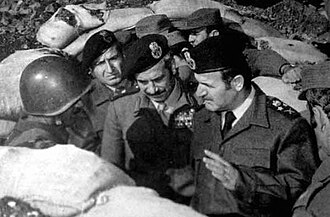
Hafez[edit]
Hafez al-Assad did his best to gain the support of the public by spending on public works, but those who still opposed him were met with brutal treatment, torture, and mass murder.[55] Hafez felt that he needed to consolidate his power quite urgently, as there was underlying sectarian tension stemming from the fact that he was part of the Shia minority.[56] Sectarianism manifested as a series of riots from Sunni civilians, whom Hafez had shot at by his authorities. The Syrian people were watched closely by Ba'athist militias and authorities for signs of dissent.
His regime eventually stabilized after Hafez involved Syria in attacking Israel during the 1973 Yom Kippur War; although the war was technically a defeat, Syrian forces had conducted themselves much better than last time.[56] That war experience helped wash the bad taste of 1967 out of everyone's mouths while making it clear that Hafez's military credentials could turn Syria into, at the very least, not a pushover.
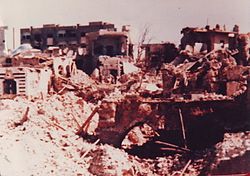
The dictator then used his expanded military to start pushing around his neighbors, most significantly by invading Lebanon during that country's civil war in the hopes of annexing some of it.[57] The Syrian military continued to occupy a big chunk of Lebanon for decades afterwards from 1976 until 2005.[58]
Closer to home, Islamist Muslim Brotherhood radicals rose up against the Shia Assad regime in 1982. This prompted a month-long siege of the city of Hama, followed by a massacre of perhaps 20,000 people described as the "deadliest act of any Arab government against its people".[59] 'Lil Bashar, though, would later do his best to surpass his daddy in brutality towards Syrians.
Bashar[edit]
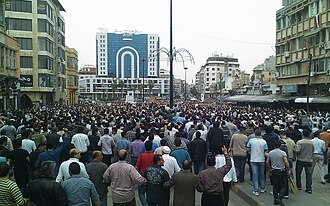
Hafez died in the year 2000, and his son Bashar won the presidency in a sham election in which he ran unopposed. This transition of power prompted a "Damascus Spring" movement calling for more democracy, but Bashar quickly put that to an end by having the leaders of the movement arrested.[60] He also vocally opposed the 2003 Iraq War, ended the occupation of Lebanon, and engaged in more hostility towards Israel.
Of course, most famous was his response to the Arab Spring of 2011. Protests had toppled longtime dictators in Tunisia and Egypt, making pro-democracy activists hopeful and Bashar fearful. Protests began in Syria, and Bashar immediately cracked down with arrests, shootings, and torture of people as young as 13.[61] This senseless bloodshed and brutality broke the loyalty of many of his citizens, and a big chunk of the military defected to form the "Free Syrian Army".
Interestingly, it's quite probable that global warming played a role in the unrest during Bashar's dictatorship. Climate change contributed to a devastating drought in Syria that started in 2007 and caused a huge influx of refugees from the arid rural areas into Syria's cities.[62] This caused more poverty and overcrowding, which are pretty obvious exacerbating factors for social unrest and revolution.
Civil war[edit]
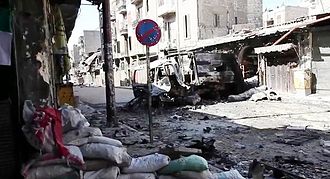
Although the initial protests were non-sectarian, it didn't take long for the escalating violence to take an ugly religious turn. Sunnis broadly opposed the Shia Assad regime, but religious minorities generally found the government to be a source of security against Sunni radicals.[63] Assad might have been a blood-soaked dictator, but at the bare minimum he at least didn't interfere in how people worshiped.

Against Assad were a variety of rebel groups, including not only the secular Free Syrian Army but also a bunch of Sunni terrorist groups like Al Qaeda. The Assad regime retaliated against the uprising with a variety of horrific war crimes including mass murder, torture, and destruction of civilian communities.[64] The Assad government also used chemical weapons during the war, although it eventually agreed under international pressure to surrender the weapons..[65]
The war quickly became internationalized when Iran got involved by mobilizing its proxy Hezbollah and other militias to protect their Shia friend Assad.[61] Russia also got involved to protect Assad, supporting him in exchange for his allowing their use of the port of Tartus.[66] The Syrian port allowed Russia to resume the old Soviet practice of maintaining a naval presence in the Mediterranean.
The United States, meanwhile, gave aid to anti-Assad forces while Israel bombed Iranian proxies.[61] The best part was that the US armed Kurds against Assad, but US-allied Turkey then launched attacks against the Kurds.
Things got even worse when the radical terrorist group DAESH rose to prominence, seizing control of a big chunk of the country and conducting itself with horrifying violence towards civilians while destroying much of Syria's cultural heritage. The collapse of the self-proclaimed caliphate left a huge power vacuum which is still being fought over by the remaining factions.[67] Amid the US' failure to do significant harm to Assad and continued Russian and Iranian support, Assad emerged with a definite upper hand in the conflict.[68] However, this was not to be. A rebel offensive in December 2024 finally overthrew him. Although Assad was finally ousted, his broken country is sadly nowhere near peace.
Religion[edit]
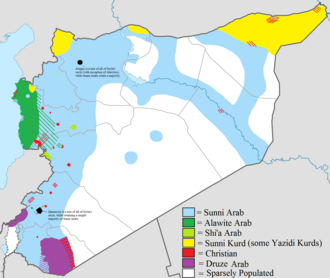
Syria has a relatively diverse religious landscape, complicating politics and giving the government an excuse to keep a tight lid on everyone.
- Sunnis are the majority, about 68% of the population.
- Shi'as are about 16% of the population, most of whom are Alawis, a minority sect within a minority sect that most of the ruling class belong to. The Alawis (Alawites) splintered off of Shi'a Islam in the 9th century and integrated pagan, gnostic, and Christian doctrines. Alawi literally means "those who adhere to the teachings of Ali," the son-in-law of the Prophet Muhammad. Sunnis consider the sect heretical (just like they consider all Shi'as to be heretics). This has been used as a justification for sectarian killings and execution of government soldiers. Often, if a soldier is captured, Sunni jihadi groups will ask "Sunni or Nusayri" (a slur for Shi'a), and kill you if you say Shi'a. Sometimes you will be told to pray, as Shi'as and Sunnis pray differently.
- Druze are about 3% of the population; they are an ethnic group with their own monotheistic religious outlook separate from others.[69] They are mostly centered in a certain area in the south of the country.
- Christians make up about 11% of the population, including the Assyrians, the people the area is actually named after.
- There are also 40,000 or so Yazidis in Syria, whose religion consists of a "Gnostic core belief structure with other elements of Zoroastrianism, Judaism, Christianity, Manichaeism, and Islam," and who are often persecuted for the unintentional (but mythologically related) resemblance of their object of worship, the Peacock Angel, to Satan in Christianity and Iblis in Islam.[70] In August of 2014 the Islamic State started trying to kill their men and turn their women and children into sex slaves. They partially succeeded.
In 1973 Hafez Assad introduced a new constitution which deleted any reference to Islam as the religion of the state and was seen by opponents of the Assad government, primarily the Syrian Muslim Brotherhood, that the Alawite-Ba'athists were not only secularists, but anti-Islamic as well. This means the Syrian government is by definition secular, making it one of few in the Middle East to be so officially.
Gallery[edit]
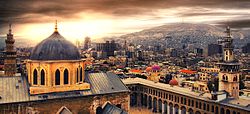
View of Damascus from the Grand Mosque (obviously prewar).

Syrian meal.
.jpg)
Al-Kafroun, village near Tartus.
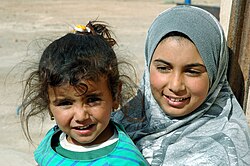
Girls in Syria.

Great Mosque of Aleppo.
References[edit]
- ↑ Syria: A Short History. Hitti, Philip. Wikisource.
- ↑ 2.0 2.1 ‘We do not have a country called Syria any more. There is nothing left’. Irish Times.
- ↑ Rollinger, Robert (2006). "The terms "Assyria" and "Syria" again". Journal of Near Eastern Studies. 65 (4): 284–287. doi:10.1086/511103.
- ↑ Syria. Online Etymology Dictionary
- ↑ See the Wikipedia article on Coele-Syria.
- ↑ Colledge, Malcolm Andrew Richard; Wiesehöfer, Josef (2014) [1998]. "Palmyra". In Hornblower, Simon; Spawforth, Antony; Eidinow, Esther (eds.). The Oxford Companion to Classical Civilization (2 ed.). Oxford University Press. ISBN 978-0-19-870677-9. p. 566
- ↑ IS leaves trail of destruction in Syria's Palmyra. BBC News.
- ↑ See the Wikipedia article on Ebla.
- ↑ Lebanon: The Phoenicians. Country Studies.
- ↑ The Phoenician Alphabet & Language. Ancient History Encyclopedia.
- ↑ 11.0 11.1 Ancient Syria. Country Studies.
- ↑ See the Wikipedia article on Roman–Parthian Wars.
- ↑ Historic Syrian 'Arch of Triumph' Destroyed by ISIS, Recreated in London. ABC News.
- ↑ See the Wikipedia article on Antioch.
- ↑ See the Wikipedia article on Christianity in Syria.
- ↑ Syria: Muslim Empires. Country Studies.
- ↑ Rashidun Government. Ancient History Encyclopedia.
- ↑ Umayyad Empire. Encyclopedia.com
- ↑ 19.0 19.1 Syria: Umayyad Caliphate. Country Studies.
- ↑ 20.0 20.1 Syria: Succeeding Caliphates and Kingdoms. Country Studies.
- ↑ 21.0 21.1 Second Crusade Ancient History Encylopedia
- ↑ See the Wikipedia article on Principality of Antioch.
- ↑ The Eastern Mediterranean, 1400–1600 A.D. Metropolitan Museum of Art.
- ↑ See the Wikipedia article on Ottoman–Mamluk War (1516–17).
- ↑ 25.0 25.1 Syria: Ottoman Empire. Country Studies.
- ↑ 26.0 26.1 26.2 Syria: Ottoman period. Britannica.
- ↑ Syria: Egyptian domination. Britannica.
- ↑ See the Wikipedia article on Egyptian–Ottoman War (1839–1841).
- ↑ Syria: Ottoman rule restored. Country Studies.
- ↑ 30.0 30.1 30.2 Syria: World War I. Country Studies.
- ↑ See the Wikipedia article on Martyrs' Day (Lebanon and Syria).
- ↑ See the Wikipedia article on Sykes–Picot Agreement.
- ↑ 33.0 33.1 33.2 The Great Syrian Revolt and the Rise of Arab Nationalism. Middle East Policy Council.
- ↑ .Miller, Joyce Laverty (October 1977). "The Syrian Revolt of 1925". International Journal of Middle East Studies. 8 (4): 545–563. doi:10.1017/S0020743800026118. p. 550–555.
- ↑ 35.0 35.1 35.2 Syria: The French Mandate. Country Studies.
- ↑ See the Wikipedia article on Great Syrian Revolt.
- ↑ Fenby, Jonathan (2012). The General: Charles De Gaulle and the France He Saved. Skyhorse. ISBN 9781620874479. p 42–47
- ↑ See the Wikipedia article on Syria–Lebanon campaign.
- ↑ 39.0 39.1 Syria: World War II and independence. Country Studies.
- ↑ Rogan, Eugene (2011). The Arabs: A Complete History. Penguin. ISBN 9780718196837. p. 244–246
- ↑ Wall, Irwin M (1991). The United States and the Making of Postwar France, 1945-1954. Cambridge University Press. ISBN 9780521402170. p. 33
- ↑ Dilks, David. Churchill and Company: Allies and Rivals in War and Peace. I.B.Tauris. ISBN 9781780769677. p.150
- ↑ The Syrian and Lebanese Question. United Nations.
- ↑ See the Wikipedia article on Battles of the Kinarot Valley.
- ↑ See the Wikipedia article on 1949 Armistice Agreements.
- ↑ See the Wikipedia article on March 1949 Syrian coup d'état.
- ↑ 47.0 47.1 Shishakli Dictatorship. Country Studies.
- ↑ 48.0 48.1 48.2 Syria: Radical Political Influence. Country Studies.
- ↑ Syria: United Arab Republic. Country Studies.
- ↑ 50.0 50.1 United Arab Republic. Encyclopedia.com
- ↑ Seale, Patrick (1990). Assad of Syria: The Struggle for the Middle East. University of California Press. ISBN 978-0-520-06976-3. p. 83
- ↑ 52.0 52.1 52.2 Syria: Neo-Baath Dominance, 1963-66. Country Studies.
- ↑ See the Wikipedia article on Corrective Movement (Syria).
- ↑ The Six-Day War And The Golan Heights. Hoover Institution.
- ↑ Ḥafiz al-Assad. Britannica.
- ↑ 56.0 56.1 Syria: The Assad Era. Country Studies.
- ↑ Timeline of the Lebanese Civil War From 1975 to 1990. ThoughtCo.
- ↑ See the Wikipedia article on Syrian occupation of Lebanon.
- ↑ See the Wikipedia article on 1982 Hama massacre.
- ↑ George, Alan (2003). Syria: neither bread nor freedom. London: Zed Books. pp. 56–58. ISBN 978-1-84277-213-3.
- ↑ 61.0 61.1 61.2 Syria's war explained from the beginning. Al Jazeera.
- ↑ Syria's civil war linked, in part, to global warming. Al Jazeera.
- ↑ For Syria's minorities, Assad is security. Al Jazeera.
- ↑ SYRIA: GOVERNMENT BOMBS RAIN ON CIVILIANS. Amnesty International.
- ↑ Armed Conflict in Syria: Overview and U.S. Response, CRS, September 17, 2014, p. 17.
- ↑ Naval base in Syria anchors Russia to Mediterranean. Navy Times.
- ↑ The Fight for ISIS’s Old Territory Is Just Beginning. Foreign Policy.
- ↑ Syria’s Assad: Last man standing amid new Arab uprisings. Associated Press.
- ↑ Druze. Britannica.
- ↑ Yazidis. Global Security.
Categories: [Anti-Western] [Asian countries] [Authoritarian regimes] [Islamism] [Middle Eastern countries] [Ongoing armed conflicts]
↧ Download as ZWI file | Last modified: 05/27/2025 16:21:56 | 115 views
☰ Source: https://rationalwiki.org/wiki/Syria | License: CC BY-SA 3.0
.svg.png)
 KSF
KSF